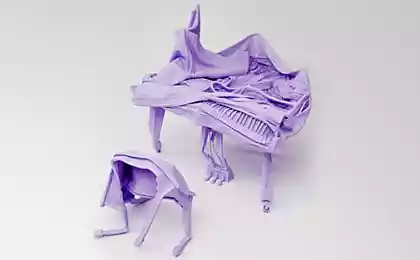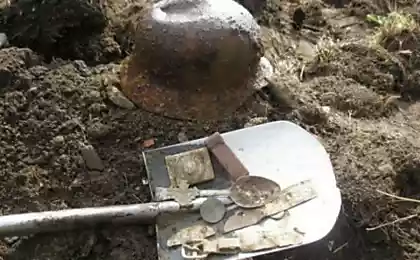897
Artifacts that should not exist
Interesting post from vmpr
Found greatly complicate the life of a scientist finds. This everyday objects or tools that are time-location in untouched rock formations should not belong to our ancestors. I repeat, unspoiled breed. That is, in places such finds were not conducted investigations, and the earth was postponed as it should be, - layers. Mel wind, put a layer, dying plants, the layer becomes thicker settled weathered rock, live animals, develop land people ...
3 photo + letter "a man from Broken Hill" in the temporal lobe of the skull could be seen a clear round hole without radial cracks. It could not be put any canine or a spear ... Only the body, flying at great speed, moreover, cylindrical (!) That can penetrate glass without breaking it, so hit the bone!
So in the body of the planet has grown meat. And those layers that were formed thanks to a man called cultural, they engaged in archeology. Those who formed the nature, belong to geology and paleontology. And what is pleasant to the scientist who is used to the fact that in the Paleolithic era people used stone, wood and bone tools, if he finds the skull of Neanderthal man ... with a nice round hole in the forehead. A luckless criminologists, who undertook to examine the skull, hasten to report: the bullet hole. Moreover, if one so bad skull dug up can be attributed to the joker. And if there are several in different places? If the bullet holes were found on the skulls of mammoths? But why only mammoths? There is a lovely example of a bullet hole in the skull of a lizard ... How can you not howl? So that damned man is not only the same age of the dinosaurs! He also stood at a level of development, to which we got (or may not) only at the end of the II millennium. That's not in any frame does not climb. That is why try to omit facts ignored. The golden rule is: if you want to jack does not come out, do not think it vain. That is, do their own direct investigations, and questionable findings simply do not touch.
And in the XIX century, to be exact, in 1830, in Philadelphia quarry was found a piece of marble, covered with strange inscriptions and some bas-reliefs.
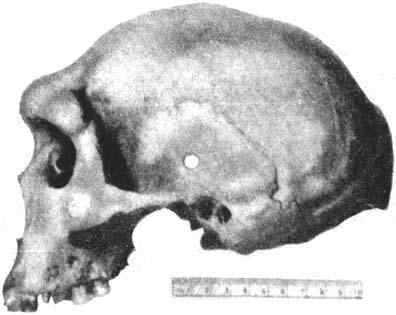
The skull of an ancient bison, contemporary man from Broken Hill. Only he is not found in Africa, and in the present Yakutia. The hole in the frontal bone has no radial cracks. Soft perhaps lead the body to flatten on impact with the frontal armor of the skull ... and then "cumulative" effect struck bone
David Brewster discovered in a piece of Devonian sandstone (the upper limit of the period - 360 million years ago), a well-preserved iron nail. "The stone in the quarry Ningude - reported Brewster - consists of alternating layers of hard rock and soft, clay-like substance called Thiel. The layer thickness of the stone varies from 6 inches to 6 feet. The thickness of the piece, which was found a nail, 9 inches, the tip of the nail was nominated for a half-inch in Thiel (it was all eaten with rust), and the rest was lying along the surface of the stone, a hat was at a depth of an inch in stone ».
Cremo results and an article from the American Journal of mid-nineteenth century by beckoning called "relic of a bygone era».
"A few days ago in the rock mountain Meeting House in Dorchester, a few dozen meters from the house of Reverend Hall was made a huge explosion. He lifted into the air enormous masses of stone, some pieces weighed several tons, and scattered them in all directions. Among the pieces of stone was found by a metal vessel, divided into two parts explosion. When joining two pieces turned bell jar height of 4 1/2 inches and 6 1/2 inches at the base, two 1/2 inch at the edges and a thickness of about 1/8 inch. Color vessel resembled zinc or any alloy in which silver was considerable portion. On one side it shows the 6 figures or 1 flower or bouquet, beautifully inlaid with pure silver, and around the lower part of the vine avoided or garland, also inlaid with silver. Some craftsman with great art made engraving, carving and inlay. This amazing and unknown vessel was a solid Swiss sandstone at a depth of 15 feet below the surface. He is now in the possession of Mr. John Cattell. Dr. D.V.K. Smith, who recently traveled to the East, and examined hundreds of extraordinary items and housewares which has drawings of them have never seen anything like it. He sketched the vessel and took its exact dimensions, to transmit this teaching. Undoubtedly, this curiosity, as mentioned above, flew out of the blocks of stone; but would not it be Professor Agassiz and other scientists so kind as to tell how it got there? This issue is worthy of study, as there is no deceit »
The editorial staff even joked that the vessel was forged, it is likely, the legendary hero of Tubal Cain. But here it is important to note that the vessel was within the formation of the Swiss sandstone, the formation of which is well known - 600 million years ago. At the time of this discovery wrote a lot, not only in the American press. In those years, a clear time of birth of mankind has not been invented.

The brown coal in France was discovered strange chalk ball 6 cm in diameter and weighing about 310 g If the message about the relic vase can be trusted, and you can not believe that this artifact described the French Academician of Lana Maximilian Mellevil. And he said that before such messages did not believe, but then witnessed the discovery and accuse their eyes and distortion of reality is no longer able to. Ball, as he put it, really was inside a coal seam, because the left dents corresponding to the position of the ball in the coal seam. "More than 4/5 of its weight is really steeped in black bitumen - meticulously described the discovery Mellevil - this color goes to the top in the hard grains obviously occurred because of contact with a magnet, in which the ball is so long. On the contrary, the top of which is in contact with the hard rock, has preserved its natural color - matt white chalk ... I can say that the ball is completely intact, it does not have traces of use in ancient times. Top design in the place intact, and there can be seen no fractures or cavities, which as we could assume the ball could fall from above ... On the basis of a single fact, even so well established, I do not dare to bring a bold conclusion that the man was a contemporary of the Paris Basin lignite ... I am writing this review with the sole purpose - to notify about a strange and surprising discovery, and that whatsoever on this subject, I do not presume to give any explanation. I am content to give it a science, and I will wait before you formulate an opinion on this subject, for the future thanks to the discoveries I can assess the value of this discovery in Montagu ».
Explanation of the origin of the ball have advanced a lot, although most agree that the ball is of natural origin. Mellevil on this matter objected, as noted, that "while the treated it (the ball) was not separated from that piece of stone, from which he was beaten, and that he was separated with one blow after been completed, and thus there was this kind of shock fracture. " He added that before the workers reported if found on time once petrified wooden objects - apparently made by the human hand. Academician himself attributed the manufacture of the ball about 45 - 55 million years ago, based on the time of formation of the reservoir lingita. And no one was able to convince the academician, that the date is uncertain. He trusted only his own eyes.
Not only balls found in coal seams. Repeatedly, there were reports about the discovery of gold chains. One such discovery made morrisonvilskaya housewife, decided podtopit coal stove. When she broke a big lump of coal, I saw sticking out of his gold chain. Moreover, part of the chain fell out of a piece of coal, and some still sitting firmly in it. Frank Kenwood from a small town in Arkansas found inside a piece of coal metal mug. "When I was working in 1912 at the municipal plant for the production of electric locomotives in Thomas (Oklahoma), - he said, - I somehow got a big solid chunk of coal which was too large to be able to use, so I broke it sledgehammer. From the center of a piece of steel fell circle, leaving an imprint on it the same shape. "
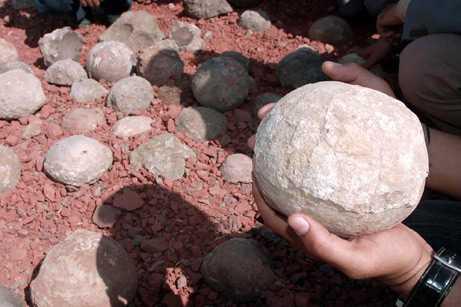
Metal Hammer, enclosed in a block of stone from the Cretaceous period
Some of the miners who worked in the deep faces, talked about the strange "polished" concrete blocks that form a sometimes whole wall collapses at or dropped directly into the drift.
In Africa, miners found in coal seams strange metal artifacts spherical shape with three grooves exactly in the center. African hollow balls were even in the Museum of the City Klerisdorpa (South Africa). "These balls have a fibrous structure inside and the shell around it, - said Cremo curator of the museum - very hard, and they can not even scratch the steel objects ... These areas - a perfect mystery. They look as if they made a man, but still at a time when they hit the rock on Earth there were no intelligent life. They are not like anything I've seen before ».
In the 60 years the US Geological Journal reported that "in the district of Macoupin County (Illinois) in the coal seam covered with 2 feet of shale, at 90 feet below the earth's surface have been found human bones ... They were covered with a crust of solid black as coal , gloss agents. But when the cover was removed, it was found that the bones were white and natural. " Maximum Antiques for-salable - 320 million years old, the minimum - 286 million years.
The Cretaceous formations found metal pipes. As you know, in the Cretaceous period, there was no man - no reasonable or unreasonable. But the pipe is formed due to natural circumstances, too, could not!
Many artifacts raised from the depths during the drilling of wells in the Americas. Of course, when drilling can be accidentally hurt and layers of voids, where before there were burial, and "drag" artifacts, much of their "bury". But the strange discoveries and actually too much. There are ancient coins, copper tools (tips, hatchets), pieces of pottery, stone products. During the sinking of one of the wells was found an ancient figure of a woman made of clay - the description is no different from European models of Paleolithic art. Such figures with a powerful body and large breasts as well as names - Venus figurines.
Author: VadimIS
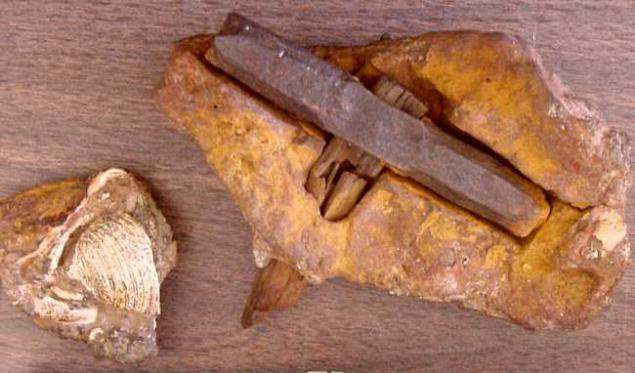
Source:
Found greatly complicate the life of a scientist finds. This everyday objects or tools that are time-location in untouched rock formations should not belong to our ancestors. I repeat, unspoiled breed. That is, in places such finds were not conducted investigations, and the earth was postponed as it should be, - layers. Mel wind, put a layer, dying plants, the layer becomes thicker settled weathered rock, live animals, develop land people ...
3 photo + letter "a man from Broken Hill" in the temporal lobe of the skull could be seen a clear round hole without radial cracks. It could not be put any canine or a spear ... Only the body, flying at great speed, moreover, cylindrical (!) That can penetrate glass without breaking it, so hit the bone!
So in the body of the planet has grown meat. And those layers that were formed thanks to a man called cultural, they engaged in archeology. Those who formed the nature, belong to geology and paleontology. And what is pleasant to the scientist who is used to the fact that in the Paleolithic era people used stone, wood and bone tools, if he finds the skull of Neanderthal man ... with a nice round hole in the forehead. A luckless criminologists, who undertook to examine the skull, hasten to report: the bullet hole. Moreover, if one so bad skull dug up can be attributed to the joker. And if there are several in different places? If the bullet holes were found on the skulls of mammoths? But why only mammoths? There is a lovely example of a bullet hole in the skull of a lizard ... How can you not howl? So that damned man is not only the same age of the dinosaurs! He also stood at a level of development, to which we got (or may not) only at the end of the II millennium. That's not in any frame does not climb. That is why try to omit facts ignored. The golden rule is: if you want to jack does not come out, do not think it vain. That is, do their own direct investigations, and questionable findings simply do not touch.
And in the XIX century, to be exact, in 1830, in Philadelphia quarry was found a piece of marble, covered with strange inscriptions and some bas-reliefs.

The skull of an ancient bison, contemporary man from Broken Hill. Only he is not found in Africa, and in the present Yakutia. The hole in the frontal bone has no radial cracks. Soft perhaps lead the body to flatten on impact with the frontal armor of the skull ... and then "cumulative" effect struck bone
David Brewster discovered in a piece of Devonian sandstone (the upper limit of the period - 360 million years ago), a well-preserved iron nail. "The stone in the quarry Ningude - reported Brewster - consists of alternating layers of hard rock and soft, clay-like substance called Thiel. The layer thickness of the stone varies from 6 inches to 6 feet. The thickness of the piece, which was found a nail, 9 inches, the tip of the nail was nominated for a half-inch in Thiel (it was all eaten with rust), and the rest was lying along the surface of the stone, a hat was at a depth of an inch in stone ».
Cremo results and an article from the American Journal of mid-nineteenth century by beckoning called "relic of a bygone era».
"A few days ago in the rock mountain Meeting House in Dorchester, a few dozen meters from the house of Reverend Hall was made a huge explosion. He lifted into the air enormous masses of stone, some pieces weighed several tons, and scattered them in all directions. Among the pieces of stone was found by a metal vessel, divided into two parts explosion. When joining two pieces turned bell jar height of 4 1/2 inches and 6 1/2 inches at the base, two 1/2 inch at the edges and a thickness of about 1/8 inch. Color vessel resembled zinc or any alloy in which silver was considerable portion. On one side it shows the 6 figures or 1 flower or bouquet, beautifully inlaid with pure silver, and around the lower part of the vine avoided or garland, also inlaid with silver. Some craftsman with great art made engraving, carving and inlay. This amazing and unknown vessel was a solid Swiss sandstone at a depth of 15 feet below the surface. He is now in the possession of Mr. John Cattell. Dr. D.V.K. Smith, who recently traveled to the East, and examined hundreds of extraordinary items and housewares which has drawings of them have never seen anything like it. He sketched the vessel and took its exact dimensions, to transmit this teaching. Undoubtedly, this curiosity, as mentioned above, flew out of the blocks of stone; but would not it be Professor Agassiz and other scientists so kind as to tell how it got there? This issue is worthy of study, as there is no deceit »
The editorial staff even joked that the vessel was forged, it is likely, the legendary hero of Tubal Cain. But here it is important to note that the vessel was within the formation of the Swiss sandstone, the formation of which is well known - 600 million years ago. At the time of this discovery wrote a lot, not only in the American press. In those years, a clear time of birth of mankind has not been invented.

The brown coal in France was discovered strange chalk ball 6 cm in diameter and weighing about 310 g If the message about the relic vase can be trusted, and you can not believe that this artifact described the French Academician of Lana Maximilian Mellevil. And he said that before such messages did not believe, but then witnessed the discovery and accuse their eyes and distortion of reality is no longer able to. Ball, as he put it, really was inside a coal seam, because the left dents corresponding to the position of the ball in the coal seam. "More than 4/5 of its weight is really steeped in black bitumen - meticulously described the discovery Mellevil - this color goes to the top in the hard grains obviously occurred because of contact with a magnet, in which the ball is so long. On the contrary, the top of which is in contact with the hard rock, has preserved its natural color - matt white chalk ... I can say that the ball is completely intact, it does not have traces of use in ancient times. Top design in the place intact, and there can be seen no fractures or cavities, which as we could assume the ball could fall from above ... On the basis of a single fact, even so well established, I do not dare to bring a bold conclusion that the man was a contemporary of the Paris Basin lignite ... I am writing this review with the sole purpose - to notify about a strange and surprising discovery, and that whatsoever on this subject, I do not presume to give any explanation. I am content to give it a science, and I will wait before you formulate an opinion on this subject, for the future thanks to the discoveries I can assess the value of this discovery in Montagu ».
Explanation of the origin of the ball have advanced a lot, although most agree that the ball is of natural origin. Mellevil on this matter objected, as noted, that "while the treated it (the ball) was not separated from that piece of stone, from which he was beaten, and that he was separated with one blow after been completed, and thus there was this kind of shock fracture. " He added that before the workers reported if found on time once petrified wooden objects - apparently made by the human hand. Academician himself attributed the manufacture of the ball about 45 - 55 million years ago, based on the time of formation of the reservoir lingita. And no one was able to convince the academician, that the date is uncertain. He trusted only his own eyes.
Not only balls found in coal seams. Repeatedly, there were reports about the discovery of gold chains. One such discovery made morrisonvilskaya housewife, decided podtopit coal stove. When she broke a big lump of coal, I saw sticking out of his gold chain. Moreover, part of the chain fell out of a piece of coal, and some still sitting firmly in it. Frank Kenwood from a small town in Arkansas found inside a piece of coal metal mug. "When I was working in 1912 at the municipal plant for the production of electric locomotives in Thomas (Oklahoma), - he said, - I somehow got a big solid chunk of coal which was too large to be able to use, so I broke it sledgehammer. From the center of a piece of steel fell circle, leaving an imprint on it the same shape. "

Metal Hammer, enclosed in a block of stone from the Cretaceous period
Some of the miners who worked in the deep faces, talked about the strange "polished" concrete blocks that form a sometimes whole wall collapses at or dropped directly into the drift.
In Africa, miners found in coal seams strange metal artifacts spherical shape with three grooves exactly in the center. African hollow balls were even in the Museum of the City Klerisdorpa (South Africa). "These balls have a fibrous structure inside and the shell around it, - said Cremo curator of the museum - very hard, and they can not even scratch the steel objects ... These areas - a perfect mystery. They look as if they made a man, but still at a time when they hit the rock on Earth there were no intelligent life. They are not like anything I've seen before ».
In the 60 years the US Geological Journal reported that "in the district of Macoupin County (Illinois) in the coal seam covered with 2 feet of shale, at 90 feet below the earth's surface have been found human bones ... They were covered with a crust of solid black as coal , gloss agents. But when the cover was removed, it was found that the bones were white and natural. " Maximum Antiques for-salable - 320 million years old, the minimum - 286 million years.
The Cretaceous formations found metal pipes. As you know, in the Cretaceous period, there was no man - no reasonable or unreasonable. But the pipe is formed due to natural circumstances, too, could not!
Many artifacts raised from the depths during the drilling of wells in the Americas. Of course, when drilling can be accidentally hurt and layers of voids, where before there were burial, and "drag" artifacts, much of their "bury". But the strange discoveries and actually too much. There are ancient coins, copper tools (tips, hatchets), pieces of pottery, stone products. During the sinking of one of the wells was found an ancient figure of a woman made of clay - the description is no different from European models of Paleolithic art. Such figures with a powerful body and large breasts as well as names - Venus figurines.
Author: VadimIS

Source:










